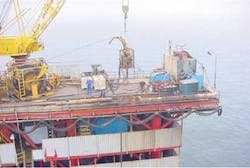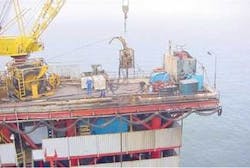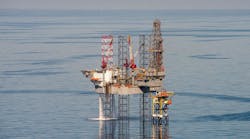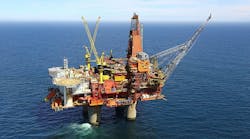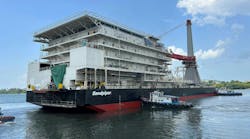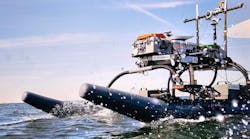Paraffin build-up in a crude export line in the Black Sea defied repeated attempts at clearance. After six years of obstructions, Romanian operator Petromar turned to chemicals specialist Brenntag Oil & Gas for assistance.
The 7-km, 6 5/8-in. diameter pipeline connected two fixed platforms, P3 and P6, and had been used for salt water injection as well as oil export. Clogging first became apparent in the late 1990s, eventually leading to suspension of the line. Petromar made several attempts to re-open it, at one point retrieving it to the surface for cutting, but to no avail.
Brenntag was brought in during summer 2004, having successfully freed up similarly obstructed onshore and offshore pipelines, flowlines and gas-lifted wells elsewhere, including installations in the Gulf of Mexico. The company’s technique involves injection of the N-SPEC range of chemicals, which are formulated to remove the adhesive characteristics of typical deposits such as black powder, hydrates, paraffin, and scales.
Once the treated sludge has been dislodged from the inner pipeline wall, it is shifted through the line by the N-SPEC 50 chemical batch and a specially-designed pig, which has a travelling speed of 1-1.5 m/s. This set-up, which can penetrate and remove wax and paraffin plugs, recently was approved by authorities in Scandinavia and the UK for offshore use. The Petromar application represented its first application in a European offshore context.
Initially, the Brenntag team removed all fluids and solids in both open ends of the pipeline at each platform before injecting N-SPEC 50 dispersant, diluted with water. Next, the P3 entry point was pressurized, with simultaneous monitoring of the pipeline end at P6. The same procedure then was repeated in the opposite direction.
While the chemical was doing its work subsea, the team decided to increase the pressure to create an annulus between the pipeline’s inner wall and the paraffin plugs, via the material’s re-rounding effect on the steel pipes. After several days, they managed to generate low-level flow within the line.
To stimulate flow further, the team decided to increase movement by inducing single and dual pressure cycles. This involved pressurizing and de-pressurizing one side in alternating steps, varying the speed from fast to slow.
The outcome of this ‘hydraulic shock therapy’ was improved throughput, albeit still with a low-level flow. The routine had to be sustained for a further 16 days before a near-continuous flow could be established.
Because the chemicals need time to disperse and dissolve into the very old, solidified paraffin, engineers left the offshore site and returned in October 2004. Then, after cleaning both ends of the pipeline, they introduced a fresh batch of N-SPEC chemicals and inserted coiled tubing lengths of around 1 km at each end. This measure proved that 2 km of the line was now open. Thereafter, continued pressurization added to the impact of the chemicals, and led to gradual improvements, with increased paraffin evacuation. Eventually, the line was re-opened for service in December 2005.
